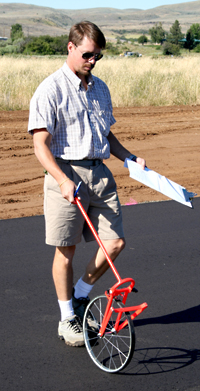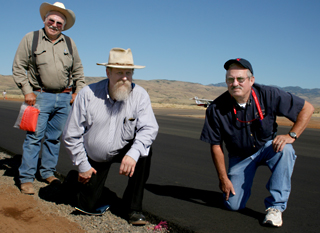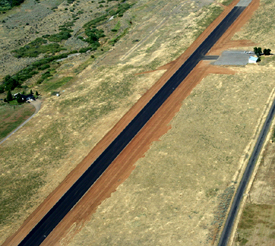
|
CONNECTIONS
|
IDAHO
ITD
HOME
IDAHO DMV
ITD NEWS
HIGHWAY
SAFETY
IDAHO STATE
POLICE
TRAVEL SERVICES
STATE OF IDAHO
NATIONAL
AASHTO
AAMVA
AAA of IDAHO
FEDERAL HIGHWAYS
FEDERAL AVIATION
IDAHO STATE POLICE
NHTSA
NTSB
TRB
U.S. DOT
Idaho
Transportation
Department
Public Affairs Office
P.O. Box 7129
Boise, ID 83707
208.334.8005
Fax: 208.334.8563
Email


Persistence pays off for 50-year-old airport
Same
approach, whole new look
David Craig paced back and forth next to a half-mile ribbon of black asphalt like an expectant father outside a hospital delivery room. He couldn’t wait to formally introduce the product of his eight-year labor – a newly paved airstrip near Midvale that he and community leaders believe will put the town on the aviation map.
 Representatives
of the Idaho Transportation Department’s Division of Aeronautics
flew into the airport Tuesday morning to inspect the project, measure
the surrounding terrain for obstructions and generally congratulate
Craig for his persistence.
Representatives
of the Idaho Transportation Department’s Division of Aeronautics
flew into the airport Tuesday morning to inspect the project, measure
the surrounding terrain for obstructions and generally congratulate
Craig for his persistence.
Landing marks left by their Cessna 205 at the east end of the strip stood alone … theirs was only the second aircraft to land on the new runway. The fragrance of fresh asphalt – less than 18 hours old – still lingered.
The official entourage delivered no cigars, no helium-filled balloons. Not even a bottle of champagne to christen the new facility. Instead, the visitors brought a positive review and an informal declaration: the new, improved Midvale Airport is officially open and accepting visitors.
The contrast is clearly visible to pilots flying overhead – green native grass in transition to a golden brown with a swath of deep black running east and west. The incorporated town of Midvale, population 176, is a stone’s throw to the east, ready to welcome aircraft traffic they know will come.
Annexed just three weeks earlier by the city of Midvale, the airport will be the home of about five aircraft, including Craig’s Cherokee 180. Most of its traffic will be for general aviation and agriculture.
“It means the whole world. It means I don’t have to wash my plane as often or replace the prop because of the gravel,” Craig said. “This is the biggest thing to happen in Midvale since they busted a pot operation about five years ago up in those hills,” he said, pointing to the south.
 Conversation
then took a serious turn.
Conversation
then took a serious turn.
“We have worked a long time for this. I have accomplished what I started. I am very proud of this… everybody is tickled.”
Success didn’t come over night, though. It is measured in years – about eight of them.
Efforts to secure a grant for paving the community’s gravel airstrip began in about 1997. Because of the cost and relative isolation of the airstrip, progression up the list of airport improvement projects statewide was slow.
The project was approved in 2002 but funding wasn’t available until this year, explains Bill Statham, manager of airport development for the aeronautics division.
“We simply just did not have the money available to do the paving. We’ve worked with them to do small projects, but it’s been on the books for about eight years.”
The division awarded a $170,000 grant to the city earlier this year, augmenting almost $19,000 the city invested in paving a ramp/tarmac connecting to a single hangar. The local match also included project preparation and administration and base material for the new surface.
The project was one of four funded by aviation fuel taxes through the Idaho Airport Aid Program this year. Others included pavement rehabilitation or paving work at American Falls, Downey and Soda Springs. Midvale’s is the first airport to be converted from gravel to asphalt in three years, Statham says.
“I would venture to say that this is one of the purest examples of economic development in the state,” Statham adds.
“It probably will grow like the airport at Mackay,” said Ray Glidden, director of flight operations for the aeronautics division. “Access to the airport could lead to new business opportunities and become a real benefit to the economy. And all of this has been accomplished at the local level, which makes it even more gratifying.”
 The
Midvale Airport is the only public airport between Council and Weiser.
It was carved from the native vegetation in 1946 and was used initially
to train military personnel. The strip hadn’t changed much during
the ensuing half-century, except for general maintenance by a small,
dedicated cadre of local pilots.
The
Midvale Airport is the only public airport between Council and Weiser.
It was carved from the native vegetation in 1946 and was used initially
to train military personnel. The strip hadn’t changed much during
the ensuing half-century, except for general maintenance by a small,
dedicated cadre of local pilots.
Craig, retired from his own construction company, appears as comfortable behind the controls of his Cherokee as he was behind a backhoe. The 66-year-old Midvale native began flying out of the gravel airstrip in 1955 and holds the working/honorary title of airport manager.
“They doubled my salary as airport manager every year,” he said. “Zero is still zero.”
He provided the energy and drive behind the paving project that began July 6 and concluded less than two weeks later. Craig logged long, tiring days, preparing for the paving crew; he set the blue-topped hubs that dictate the grade of the asphalt surface. He guarded each like a mother hen during the paving process.
In its new state, the Midvale Airport is about 60 feet wide and 2,875 feet long. A six-inch base supports the two-inch asphalt surface. It generally runs east and west (250 degrees and 70 degrees) and is located at an elevation of 2,618 feet. No services are available, except for a local-calls-only telephone (meant to be a closely guarded secret) attached to the western exterior wall of the hangar.
The airport will remain open as long as weather permits (about three months longer than when it was a gravel strip). Craig, reflecting the heart of a true retiree, vows not to plow the strip, so when winter snow falls, the airport will close to air traffic.